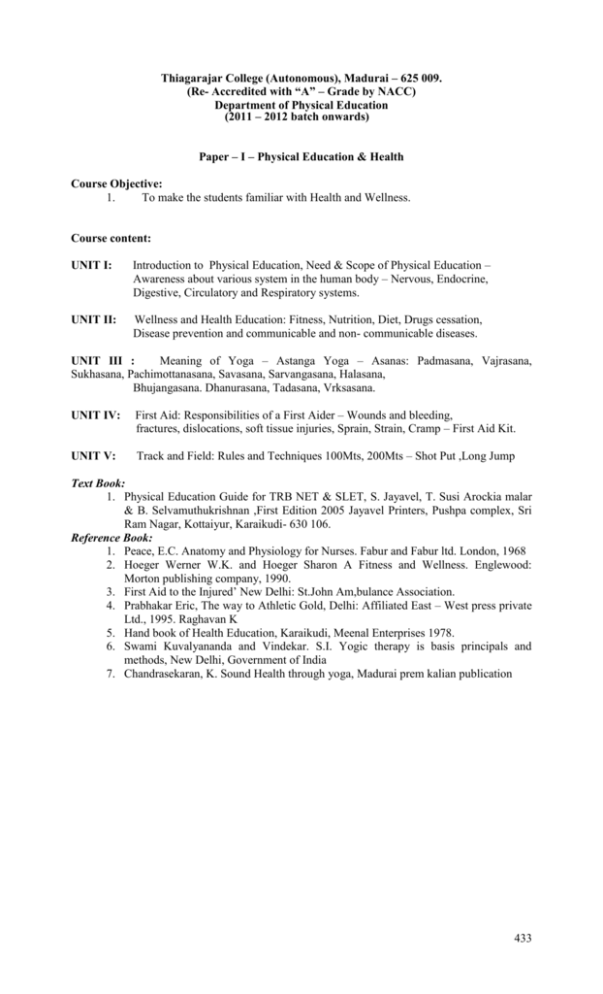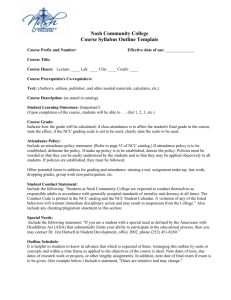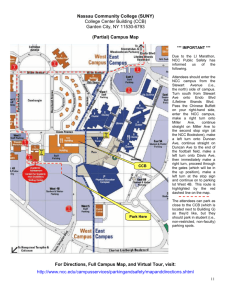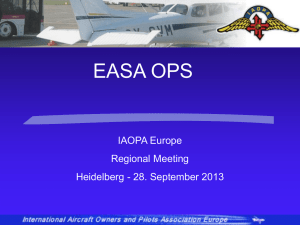Part-V - Thiagarajar College
advertisement

Thiagarajar College (Autonomous), Madurai – 625 009. (Re- Accredited with “A” – Grade by NACC) Department of Physical Education (2011 – 2012 batch onwards) Paper – I – Physical Education & Health Course Objective: 1. To make the students familiar with Health and Wellness. Course content: UNIT I: Introduction to Physical Education, Need & Scope of Physical Education – Awareness about various system in the human body – Nervous, Endocrine, Digestive, Circulatory and Respiratory systems. UNIT II: Wellness and Health Education: Fitness, Nutrition, Diet, Drugs cessation, Disease prevention and communicable and non- communicable diseases. UNIT III : Meaning of Yoga – Astanga Yoga – Asanas: Padmasana, Vajrasana, Sukhasana, Pachimottanasana, Savasana, Sarvangasana, Halasana, Bhujangasana. Dhanurasana, Tadasana, Vrksasana. UNIT IV: First Aid: Responsibilities of a First Aider – Wounds and bleeding, fractures, dislocations, soft tissue injuries, Sprain, Strain, Cramp – First Aid Kit. UNIT V: Track and Field: Rules and Techniques 100Mts, 200Mts – Shot Put ,Long Jump Text Book: 1. Physical Education Guide for TRB NET & SLET, S. Jayavel, T. Susi Arockia malar & B. Selvamuthukrishnan ,First Edition 2005 Jayavel Printers, Pushpa complex, Sri Ram Nagar, Kottaiyur, Karaikudi- 630 106. Reference Book: 1. Peace, E.C. Anatomy and Physiology for Nurses. Fabur and Fabur ltd. London, 1968 2. Hoeger Werner W.K. and Hoeger Sharon A Fitness and Wellness. Englewood: Morton publishing company, 1990. 3. First Aid to the Injured’ New Delhi: St.John Am,bulance Association. 4. Prabhakar Eric, The way to Athletic Gold, Delhi: Affiliated East – West press private Ltd., 1995. Raghavan K 5. Hand book of Health Education, Karaikudi, Meenal Enterprises 1978. 6. Swami Kuvalyananda and Vindekar. S.I. Yogic therapy is basis principals and methods, New Delhi, Government of India 7. Chandrasekaran, K. Sound Health through yoga, Madurai prem kalian publication 433 Thiagarajar College (Autonomous), Madurai – 625 009. (Re- Accredited with “A” – Grade by NACC) Department of Physical Education (2011 – 2012 batch onwards) Paper – I I– Foundations of Yoga & Physical Education Course Objective: 1. To make the students familiar with Yoga & Physical Education techniques. Course content: UNIT I: Concepts of Yoga & Physical Education – Aim , Objectives & Scope of Yoga -Guidelines for practicing Yogic Techniques - Difference between Asanas and Physical Exercises. UNIT II: Meaning of Pranayama, Values of Pranayama – Types - Nadi Suddhi –Nadi Sodhana – Bhastrika – Bhamari- Meditation. UNIT III: Careers in Physical Education, Teaching Coaching, Fitness and Health related Opportunities, Management, Media and other related opportunities. UNIT IV: Basketball: History, Organization. Skills – Rules and Regulations, Lay out Equipments, Officiating. UNIT V: Volleyball: History, Organization. Skills – Rules and Regulations, Lay out Equipments, Officiating. Text Book: 1. Physical Education Guide for TRB NET & SLET, S. Jayavel, T. Susi Arockia malar & B. Selvamuthukrishnan ,First Edition 2005 Jayavel Printers, Pushpa complex, Sri Ram Nagar, Kottaiyur, Karaikudi- 630 106. Reference Book: 1. Wirest Deborah, A and Charles A. Bucher, Foundations of Physical Education. New Delhi: B Publication Pvt Ltd., 1979. 2. Dhanaraj V. Hubert, Volley ball, A modern Approach. Patiala, SAINSNIS, 1991. 3. Reddi B.R.Scientific Basketball , 4. Pranayama – Swamikuvalayananda, Kaivalyadhama, Lonavla. 5. Moorthy A.m. and Alagesan .S, Yoga theraphy TPH coimbatore – 2004. 6. Chandrasekaran, K. Sound Health through yoga, Madurai prem kalian publication 434 Thiagarajar College (Autonomous), Madurai – 625 009. (Re- Accredited with “A” – Grade by NACC) Department of Physical Education (2011 – 2012 batch onwards) Certificate Course in YOGA Course Objective: 1. To make the students familiar with the need and Scope of Yoga. Course content: “Principles and practice of Yoga” UNIT I: Meaning, History, Aims, Objectives and Scope of Yoga – Limbs of Yoga – Asanas – Essentials of Yogic practices – Classification of Asanas – Meditative asanas – Relaxative asanas – Cultural asanas – Pranayama – Different phases in Pranayama Practices – Puraka (Inhalation) – Kumbhaka (Retention ) and Rechaka (Exhalation) – Meaning of Meditation - Kriyas UNIT II: ( Practical) Asanas: Padmasana – Vajarasana, Yogamudra , Pachimottanasana, Makrasan , Bhujankasna, Salabhasana, Dhanurasana, Savasana, Vipatitakarani, Vrksana, Pranayama: Sitali, Sitakari, Suryabhedana, Ujjavi, Bhamari, Bhastrika. Kriyas: Trataka , Kapalabhati Text Book: 1. Chandrasekaran, K. Sound Health through yoga, Madurai prem kalian publication. Reference Book: 1. Chandrasekaran, K. Sound Health through yoga, Madurai prem kalian publication. 2. Moorthy A.m. and Alagesan .S, Yoga theraphy TPH coimbatore – 2004. 3. Swami Kuvalyananda and Vindekar. S.I. Yogic therapy is basis principals and methods, New Delhi, Government of India 4. Swami Kuvalyananda, Asabas. Lonavala; Kaivalyadhama. 5. Tirumoolar Thirumanthiram – Translation and Commentary in English by Dr. Natarajan, Ramakrishna Math, Mylapore, Madras – 600 004. 6. Textbook of Yoga – George Feuerstein, Rider and company, London. 7. Yogic Therapy – Swami Kuvalayananda and Dr. S.L. Vinekar. 435 THIAGARAJAR COLLEGE (AUTONOMOUS):: MADURAI – 625 009 NATIONAL CADET CORPS - ARMY (2011 – 2012 batch onwards) Course : I Year UG Int.Marks : 25 Ext.Marks : 75 Title of the Paper : NCC AND YOUTH EMPOWERMENT (1P5NA1) Max.Marks: 100 Sub.Code : P5NA1 Credit pts. : 01 (after completing P5NA2 paper) Objectives: To make the cadets to understand the organization of NCC and Indian Defence, to inculcate patriotism and leadership to train the cadets in civil and self defence and adventure activities Unit 1: Organization of NCC: NCC – history – Aims, Motto, cardinal principles and NCC song – NCC organization – Office of the Director General NCC – NCC Directorates –Group head quarters – Battalion – Company with rank structures of the officers concerned – customs in services Unit 2: Indian Defence organization: Indian military history – Ministry of Defence – organization of three services – Paramilitary forces – BSF, CRPF and CISF – Ranks and commands – Outline of Infantry battalion organization – battle honours and awards - entries to defence services Unit 3: Leadership Development: First war of Indian independence - Gandhiji and Non Violence – Nethaji and INA Leadership – types and traits – Man management Duty and discipline, factors affecting duty and discipline Indian Citizenship – duties and responsibilities of citizen Unit 4: Civil Defence and Self Defence: Civil defence – organization – aim and services – aid to civil authorities in emergency Fire fighting – types of fire, spreading of fire, fire extinguishing and equipments Self defence – unarmed combat – attacking and throws – vital parts of human body Unit 5: Adventure and Extension activities: Objectives of adventure training, types – trekking, cycle expedition, Mountaineering, para jumping – planning and execution Social service – campus cleaning, blood donation, eradication of illiteracy Ecology and environment – biodiversity, pollution and environmental conservation – tree plantation and pollution abatement Text Book: Mishra, R.C. 2000. A Hand book of NCC, Kanti Prakashan, Etawah Reference: Anonumous. 1995. Officers training manual. PRECIS, NCC, OTS, Kamptee 436 THIAGARAJAR COLLEGE (AUTONOMOUS):: MADURAI – 625 009 NATIONAL CADET CORPS - ARMY (2011 – 2012 batch onwards) Course Int.Marks : : II Year UG 25 Ext.Marks : 75 Title of the Paper : DRILL AND FIELD TRAINING Max.Marks: 100 Sub.Code : P5NA2 Credit pts. : 01 (including P5NA2 paper) Objectives: To impart the cadets about the weapons and accessories used in the infantry division of Indian Military and to train them in field and war tactics Unit 1: Weapon Drill and training: Arms drill – basic movements – guard of honour, strength of guard Characteristics of infantry weapons – rifle, SMC, LMG, SLR, pistol Hand grenade and 2” mortars Weapon training – stripping and assembling, loading and unloading Unit 2: Map reading: Map and its features, kinds of north, service protractor and compass, bearing and conversion of bearings, conventional signs, setting of map, finding own position, map to ground, ground to map, night march chart Unit 3: Field craft: Ground – types of grounds Movements - with and without weapons Camouflage and concealment Judging the distance, indication of target Unit 4: Tactics: Field signals, section formation Fire discipline, fire order and fire control order Patrol – types of patrol, functions of patrols Ambush – types of ambush, composition of ambush party and de-ambushing Unit 5: Warfare: Biological and chemical warfare Nuclear warfare – atom bombs, hydrogen bombs, types of burst Effects of bombs Current status of Indian Defence system, DRDO and modern warfare NPT and CTBT Text Book: Mishra, R.C. 2000. A Hand book of NCC, Kanti Prakashan, Etawah Reference: 437 Anonumous. 1995. Officers training manual. PRECIS, NCC, OTS, Kamptee THIAGARAJAR COLLEGE (AUTONOMOUS):MADURAI-9 Re-Accredited with “A” Grade by NAAC NATIONAL CADET CORPS- NAVY NCC NAVY PAPER-I (with effect from 2011-2014 Batch onwards) UG-FIRST YEAR CODE : P5NN1 UNIT-I INTRODUCTION TO NCC ORGANISATION Functions of NCC- Motto – Cardinal Principles – Aims-NCC song- NCC OrganisationOffice of the Director General NCC- NCC Directorates- Deputy Director General NCC- Group Head Quarters- Battalion- Company (with the rank structure of the officers concerned)- Units and Sub-units- Functioning of Sub-units. UNIT-II INTRODUCTION TO ARMED FORCES Supreme Commander of Armed Forces- Indian Army- Indian Navy- Indian Air ForcePara military Forces- BSF, CRPF and CISF- Equivalent rank of officers and Soldiers in Armed Forces. The Head quarters and other offices-locations and functions. UNIT-III SEAMANSHIP (a). Anchor work-Definition-types of anchor- Parts of anchor- anchor cable. (b). Rope work – Types of rope – natural, synthetic ropes – whippingsplicing – Types of knots and their uses. (c). Blocks : Definition, parts of block, types and uses. UNIT-IV BOAT WORK Types- Kinds of Boats (Whaler-Cutter and Dinghy)- Parts of Boat and their uses- size and life saving capacity of various Boats. Pulling orders- Oar and its parts. Uses of these boats during peace and war times. Sailing Boat- Types of sails-Parts of sails- sailing orders- Types of sailing boats. UNIT-V ADVENTUR, SOCIAL SERVICE ACTIVITIES AND CAMPS (a). Types of Adventure activities in NCC- Trekking, MountainearingPara jumping, Sailing and Cycle Expeditions. (b). Social Service Activities- Blood Donation- Aids awarness- tree plantation- Eradication of illiteracy- Environmental awarness programmes. (c). Camps- Different camps organised in NCC at National level and at Regional, Group and Unit level camps. REFERENCE BOOK 1. NCC Navy Hand Book- Published by The Director General NCC, DIRECTORATE, New Delhi. 2. NCC NCC Navy Hand Book- Published by 8(Andhra) Naval Unit NCC, Vijayavada 438 439 THIAGARAJAR COLLEGE (AUTONOMOUS): MADURAI-9 Re-Accredited with “A” Grade by NAAC NATIONAL CADET CORPS- NAVY NCC NAVY PAPER-II (with effect from 2011-2014 Batch onwards) UG-SECOND YEAR CODE : P5NN2 UNIT I NAVAL ORIENTATION Organisation of NAVY – Rank Structures of Officers and Sailors- Naval establishmentsBranches in Indian Navy- Naval Commands- Fleets – Types and classes of warships- Naval terms- Customs and Ceremonies. UNIT II NAVIGATION Navigation- Meaning- Definition of Basic terms – Navigational Pilotage, Latitude, Longitude, Variation, Deviation, Equator – Navigational Equipments- GPS- Navigational Chart- Informations in the Chart.. UNIT III (a). HYGIENE AND SANITATION Personal hygiene- health care and prevention of air-born and water-born diseases. Public sanitation. Roll of NCC in public hygiene and sanitation. (b). CIVIL DEFENCE Aim of civil defence – Places of National Civil Defence Colleges in India – Types of Civil Defence. (c). AID TO CIVIL AUTHORITY Definition – Different types of aid – Aims of aid – Organisation at District level- Natural Calamity etc. UNIT IV (a). NBCD– NUCLEAR BIOLOGICAL CHEMICAL DAMAGE CONTROL Expansion of NBCD, Types of fire, Ways to put off fire, Fire Triangle, Fire fighting equipments. Biological and Chemical weapons. Safety measures in Nuclear power plants and nuclear submarines during normal time and during natural calaminity. (b). OCEANIC LIVING AND NON-LIVING THINGS Limits of territorial water, EEZ, High seas, living and nonliving things in sea. (c). OCEANIC PHENOMENON Meaning of Tide, Wave, High water and low water, ocean Currents and cyclones. UNIT V (a). ANTI-SUBMARINE WARFARE-(ASW) Introduction- ASW weapons- Squids, Depth chargers, MINES: types Missiles- Torpedoes. of mines and uses. (b). SHIP MODELING Aims of Ship Modeling, Tools used- types of wood used in modeling- Consumable items in Ship modeling. REFERENCE BOOK 1. NCC Navy Hand Book- Published by The Director General NCC, DIRECTORATE, New Delhi. 2. NCC Navy Hand Book- Published by 8(Andhra) Naval Unit NCC, Vijayavada. NCC 440 THIAGARAJAR COLLEGE (AUTONOMOUS), MADURAI – 625 009 (Re- Accredited with 'A' Grade by NAAC) NATIONAL SERVICE SCHEME (From 2011 – 2014 batch onwards) YEAR : I CLASS : ALL UG COURSES CODE : P5T1NS IDEALS AND APPROACHES PART : V MARKS : 100(75+25) CREDIT : 1* (* Credit will be awarded after passing both 1st and 2nd year NSS(Part V) courses) Internal Marks : 25 (15 – Attendence; 10 – Activities) External Marks : 75 (Summative Examination at the end of the academic year) Unit - I Introduction to National Service Scheme – Philosophy of National Service Scheme – Basic concepts of National Service Scheme. Unit – II National Service Scheme programmes and activities – basic concepts and components – the role of National Service Scheme volunteers. Unit - III Regular and Special camp activities – Planning and preparation of regular activities – Planning and preparation of Camping activities. Unit – IV Social issues – Student’s participation – Environment – Women empowerment – Communal harmony – HIV and AIDS Awareness. Unit - V Community work – Rural development – Adoption of village – Identification of major issues. Reference Book : National Service Scheme Manual(Revised), Ministry of Human Resource Development of India. 441 THIAGARAJAR COLLEGE (AUTONOMOUS), MADURAI – 625 009 (Re- Accredited with 'A' Grade by NAAC) NATIONAL SERVICE SCHEME (From 2011 – 2014 batch onwards) YEAR : II CLASS : ALL UG COURSES CODE : P5T2NS COMMUNITY DEVELOPMENT PART : V MARKS : 100(75+25) CREDIT : 1* (* Credit will be awarded after passing both 1st and 2nd year NSS(Part V) courses) Internal Marks : 25 (15 – Attendence; 10 – Activities) External Marks : 75 (Summative Examination at the end of the academic year) Unit - I Gender equality – role of women – women empowerment – mother-infant welfare – female infanticide Unit – II Self help group – function of SHG – Social development – benefits to the society Unit - III Sarva Shiksha Abhiyan – frame work – girl child education – children of special need. Unit – IV Adult education – Participants – basic concepts of education – the role of education in society. Unit - V Social awareness – Voters’ awareness – general health awareness – environmental awareness – Right to information act. Reference Book : Guidelines from Ministry of Human Resource Development of India. (downloaded from the website of Ministry of HRD, Govt. of India). 442 THIAGARAJAR COLLEGE (AUTONOMOUS):: MADURAI – 625 009 YOUTH RED CROSS SOCIETY (2011 – 12 batch onwards) Course : I Year UG (SF) Int.Marks : 25 Ext.Marks : 75 Title of the Paper : ORGANIZATION OF RED CROSS SOCIETY (P5YR1) Max.Marks: 100 Sub.Code : P5YR1 Credit pts : 01 (after completing P5YR2 paper) Objectives: To make the students to know about the birth, organizational set up, principles, emblem and activities of Red Cross society and to develop leadership traits Unit 1: History and Organization of Red Cross Society: Henry Dunand – memories of Salbarino – Origin of Red Cross Society – Geneva Convention IRCS – Organization – objectives – Administrative structure – Organizational set up of Indian Red Cross Society Unit 2: Principles of Red Cross Society, Emblem and its uses: Humanity – Impartiality – Neutrality – Independence – Voluntary service – Unity – Universality Aims of Emblem – Red Cross – Red Crescent – protective use – indicative use – abuse Unit 3: IRCS activities and YRC: Types of conflicts & National Disasters – Role of Red Cross Society in relief activities Youth Red Cross Movement – origin – objectives – organization – activities Unit 4: Leadership Development: First war of Indian Independence – Gandhiji and Non Violence – Nethaji and INA Leadership – types and traits – Man management Duty and discipline, factors affecting duty and discipline Indian Citizenship – duties and responsibilities Unit 5: Civil Defence and Self Defence: Civil defence – organization – aim and services – aid to civil authorities in emergency Fire fighting – types of fire, spreading of fire, fire extinguishing and equipments Self defence – unarmed combat – attacking and throws – vital parts of human body Text Book: Nagendran, N.A. A guide to Youth Red Cross Society. Thiagarajar College, Madurai. 443 THIAGARAJAR COLLEGE (AUTONOMOUS):: MADURAI – 625 009 YOUTH RED CROSS SOCIETY (2011 – 12 batch onwards) Course : II Year UG (SF) Title of the Paper : FIRST AID Sub.Code : P5YR2 Credit pts. : 01 (including P5YR1 paper) Int.Marks : 25 Ext.Marks : 75 Max.Marks: 100 Objectives: To introduce the basic structure of human body, possible damage to the body parts and necessary first aid to the damage Unit 1: Introduction to human body and principles of First Aid: a. Skeleton – bones – joints - heart and circulation b. First aid – definition – scope and rules Unit 2: Wounds, burns and scalds: a. Wounds and hemorrhage – types – treatment – dressings b.Burns and Scalds – definition – types – treatment Unit 3: Respiration and shock: a. Respiratory tract – mechanism – types of treatment b. Shocks – types (nervous, established and electric shocks) and treatment Unit 4: Bones and fracture: a. Fracture – types and treatment b. Methods of transportation of patients Unit 5: Unconsciousness, Poisoning and Firs aid box: a. Unconsciousness – reasons and remedies b. Poisoning – types and impact c. Components of first aid box Text book: Theertham, S. Notes on First Aid. St. John Ambulance Association 444






